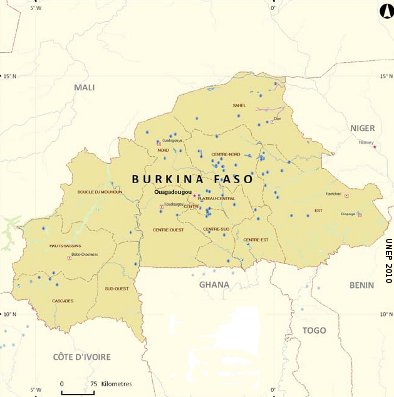Like most sub-Saharan countries, Burkina Faso's population is increasing rapidly, with an annual growth rate of 3.3%. Although the country has experienced relative growth in the past decade, it is still considered a low income country with low Gross Domestic Product (GDP). The country's economy is predominately agriculture based with some industrial facilities.
Agriculture makes up around 40% of GDP and 80% of all of the country's exports. Hence agriculture is the driving force for the country's economic and social development which is also the main source of income and employment for 85 to 90% of the population.
Climate in Burkina Faso
Climatically, the country can be divided into 3 zones from North to south, comprising the Sahelian zone in the North, with rainfall less that 600mm/year. Whilst the North Sudanian zone receives 600 to 900mm of rainfall/year, rainfall in the South Sudanian zone exceeds 900mm/year. Rainfall varies on average between 400 mm in the north to 1,200 mm in the south and west, with a number of rainy days varying between 40 and 80 and average temperature is 27−28°C. However, annual rainfall has decreased significantly over the past 60 years. This has resulted in a southward shift of over 100 km of isohyets over the period.
The southward drift in the country's rainfall gradient will affect physical variables such as vegetation, forests and transformation of soils. The country's agriculture is dependent on climatic patterns, of which the irregular nature and year to year and spatial variability have been marked since the period of severe drought in the 1970s.
The effects of climate change on agriculture are perceptible throughout the territory, more acutely where the climate is predominantly sahelian. The vagaries of the climate affect stability of agro-pastoral production and income from exports, thus weakening the country's economy. This is a situation expected to be aggravated in coming decades as different climate scenarios point towards reduced rainfall.
National Adaptation Action Plan
In 2006, a group of experts working under the Environment Ministry drew up a National Adaptation Action Plan aimed at responding to the challenges of climate change. Besides, Burkina’s National Council for Environment and Sustainable Development, an inter-ministerial group that includes independent experts and civil society, identified the four sectors most vulnerable to climate change: water, agriculture, stock raising and forestry.
Burkina Faso has also developed an action plan setting out a framework for integrated water resources management (IWRM) and identifying the specific actions and means for their implementation. The overall objective of the action plan is to contribute to the implementation of IWRM adapted to the national context and policies, as well as reflect the principles of sustainable and ecologically viable rational water resources management.
WACDEP implementation
WACDEP should focus on strengthening the capacity and activities on initiatives of the Burkina Faso government to develop and increase the practice of irrigation and agricultural extension as viable options for adaptation of Burkina Faso's agriculture to climate change. Efforts should also be made to diversification of energy supply sources to reduce Burkina Faso's dependence on systems that are vulnerable to climate change (petroleum products, fuel wood). Support be offered on development of energy from renewable sources, especially solar, for which Burkina Faso has a large and underexploited potential. Offer support for research institutions as well as training in the techniques and optimization of use of solar energy.
